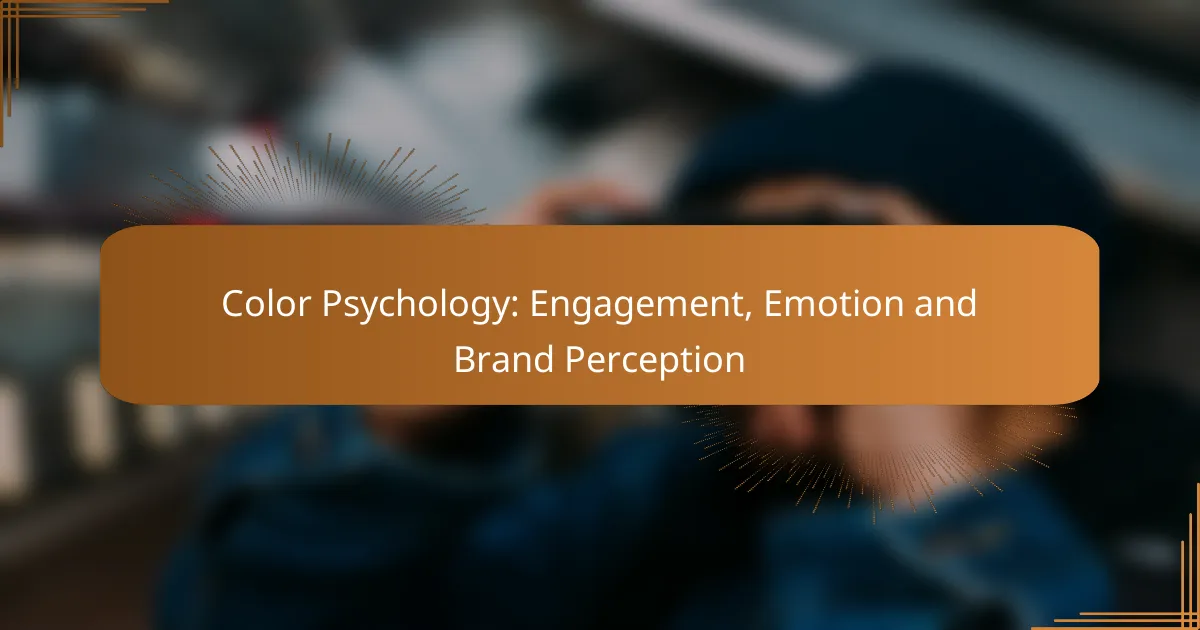Color psychology plays a vital role in shaping brand perception by eliciting specific emotions and associations that guide consumer behavior. By strategically selecting colors, brands can enhance recognition, foster emotional connections, and significantly influence engagement levels in their marketing efforts. Understanding the impact of color allows companies to create a compelling image that resonates with their target audience and drives action.
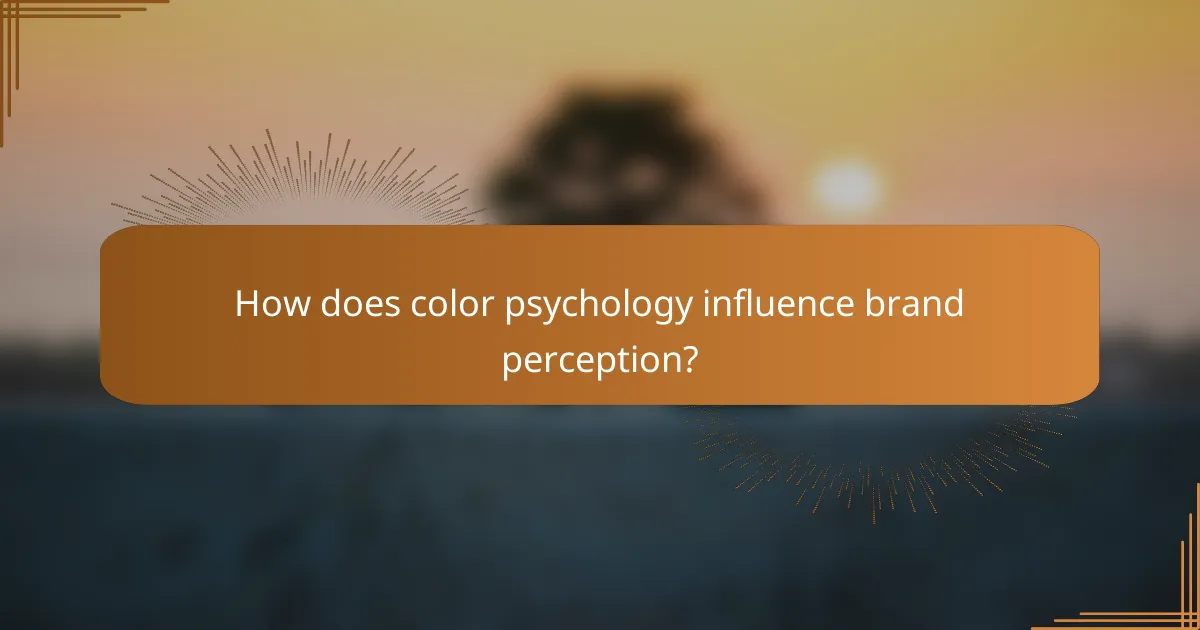
How does color psychology influence brand perception?
Color psychology significantly impacts brand perception by evoking specific emotions and associations that influence consumer decisions. Brands can leverage color to create a desired image, enhance recognition, and foster emotional connections with their audience.
Color associations with emotions
Different colors evoke distinct emotional responses. For example, blue often conveys trust and reliability, making it popular among financial institutions, while red can evoke excitement and urgency, frequently used in sales promotions. Understanding these associations helps brands choose colors that align with their messaging.
Additionally, colors can vary in meaning across cultures. For instance, white symbolizes purity in Western cultures but can represent mourning in some Eastern cultures. Brands operating globally should consider these cultural nuances when selecting their color schemes.
Impact on consumer behavior
Color can significantly influence consumer behavior, affecting everything from brand loyalty to purchasing decisions. Studies suggest that up to 90% of snap judgments about products can be based on color alone. This highlights the importance of color in marketing strategies.
Moreover, color can affect the perceived value of a product. For instance, luxury brands often use black or gold to convey exclusivity and sophistication, while vibrant colors may attract a younger demographic. Brands should analyze their target audience to select colors that resonate with their specific market segment.
Case studies of successful brands
Numerous brands have successfully utilized color psychology to enhance their image and connect with consumers. For example, Coca-Cola’s red branding is synonymous with excitement and happiness, reinforcing its identity as a refreshing beverage. This strategic use of color has contributed to its global recognition.
Another example is Starbucks, which uses green to symbolize growth and sustainability, aligning with its brand values. This color choice not only attracts environmentally conscious consumers but also fosters a sense of community and connection. Brands can learn from these examples to create effective color strategies that align with their core values and target audience.

What colors increase engagement in advertising?
Colors play a crucial role in advertising by influencing engagement levels. Certain colors evoke specific emotions and reactions, making them powerful tools for marketers aiming to capture attention and drive action.
Red for urgency and excitement
Red is often associated with urgency and excitement, making it an effective choice for calls to action. It can stimulate quick decisions, which is why it is frequently used in clearance sales or limited-time offers.
When using red, consider pairing it with contrasting colors to enhance visibility. For example, a red button on a white background can draw immediate attention, prompting users to click.
Blue for trust and reliability
Blue conveys feelings of trust and reliability, making it a popular choice for brands in finance, healthcare, and technology. Many consumers associate blue with calmness and professionalism, which can foster a sense of security.
To leverage blue effectively, use it in your branding elements, such as logos and website designs. A consistent blue palette can help reinforce brand identity and encourage customer loyalty.
Green for calmness and health
Green is linked to calmness and health, often representing nature and growth. This color is particularly effective for brands focused on wellness, sustainability, and organic products.
Incorporating green into advertising can create a soothing atmosphere. For instance, using green in packaging or promotional materials can appeal to environmentally conscious consumers and enhance brand perception.

How can brands effectively use color in marketing?
Brands can effectively use color in marketing by strategically selecting hues that resonate with their target audience and evoke desired emotions. Understanding color psychology helps brands enhance engagement and shape brand perception, leading to stronger connections with consumers.
Color palette selection strategies
When selecting a color palette, brands should consider their brand identity and the emotions they wish to evoke. For example, blue often conveys trust and reliability, making it popular among financial institutions, while red can evoke excitement and urgency, suitable for sales promotions.
It’s beneficial to create a cohesive palette that includes primary, secondary, and accent colors. A common approach is the 60-30-10 rule, where 60% of the design uses a dominant color, 30% a secondary color, and 10% an accent color to create balance and visual interest.
Testing color effectiveness
Testing color effectiveness involves A/B testing different color schemes to determine which resonates best with the audience. Brands can analyze metrics such as click-through rates and conversion rates to gauge the impact of color choices on consumer behavior.
Using tools like heat maps can help visualize user engagement with different colors on a website. This data-driven approach allows brands to refine their color strategies based on actual user preferences and behaviors.
Examples of color usage in campaigns
Successful campaigns often leverage color to reinforce brand messaging. For instance, Coca-Cola uses red to evoke energy and excitement, while Starbucks employs green to symbolize sustainability and relaxation. These color choices align with their brand values and target demographics.
Another example is the use of orange by Home Depot, which conveys a sense of affordability and enthusiasm, appealing to DIY enthusiasts. Such strategic color usage not only enhances brand recognition but also influences consumer emotions and purchasing decisions.
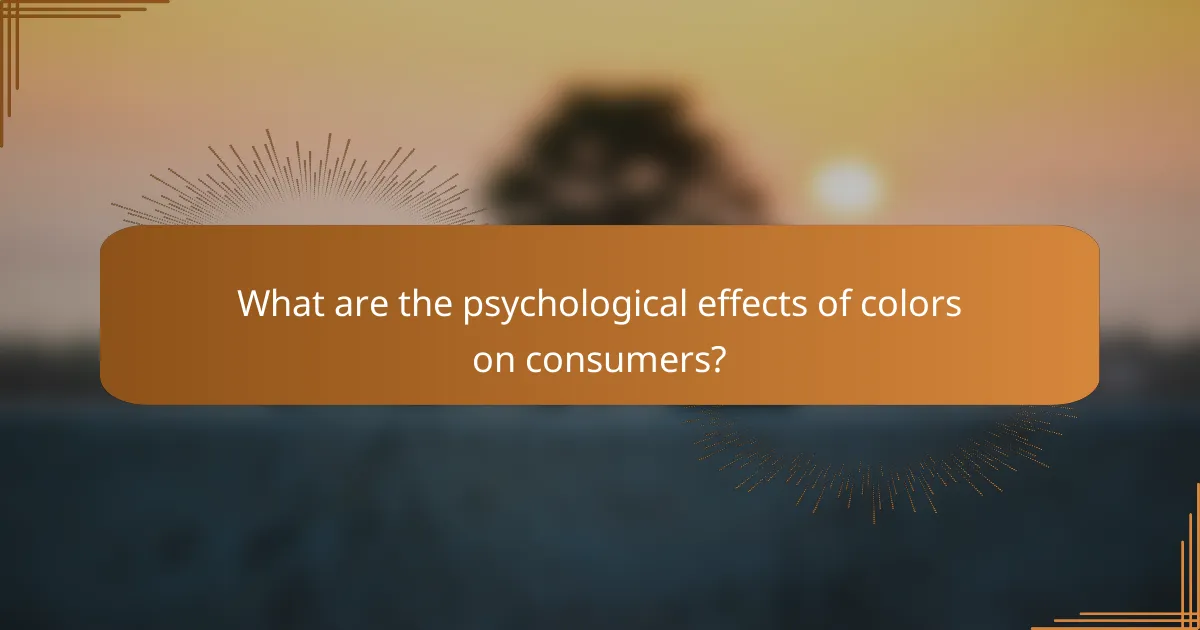
What are the psychological effects of colors on consumers?
The psychological effects of colors on consumers significantly influence their emotions, perceptions, and purchasing decisions. Different colors can evoke specific feelings and associations, impacting how a brand is perceived and how effectively it engages with its audience.
Warm colors vs. cool colors
Warm colors, such as red, orange, and yellow, often evoke feelings of excitement, warmth, and energy. These colors can stimulate appetite and create a sense of urgency, making them effective in marketing food and clearance sales.
In contrast, cool colors like blue, green, and purple tend to promote calmness, trust, and relaxation. Brands often use these colors to convey stability and professionalism, making them popular choices in finance and healthcare sectors.
Color meanings across cultures
Color meanings can vary significantly across different cultures, influencing consumer behavior. For instance, while white is associated with purity and weddings in Western cultures, it symbolizes mourning in some Eastern cultures.
Understanding these cultural nuances is crucial for global brands. For example, red may signify good luck in China, making it a favorable choice for promotional materials, while it might be seen as aggressive in other regions. Brands should tailor their color choices to align with local perceptions to enhance engagement and brand perception.
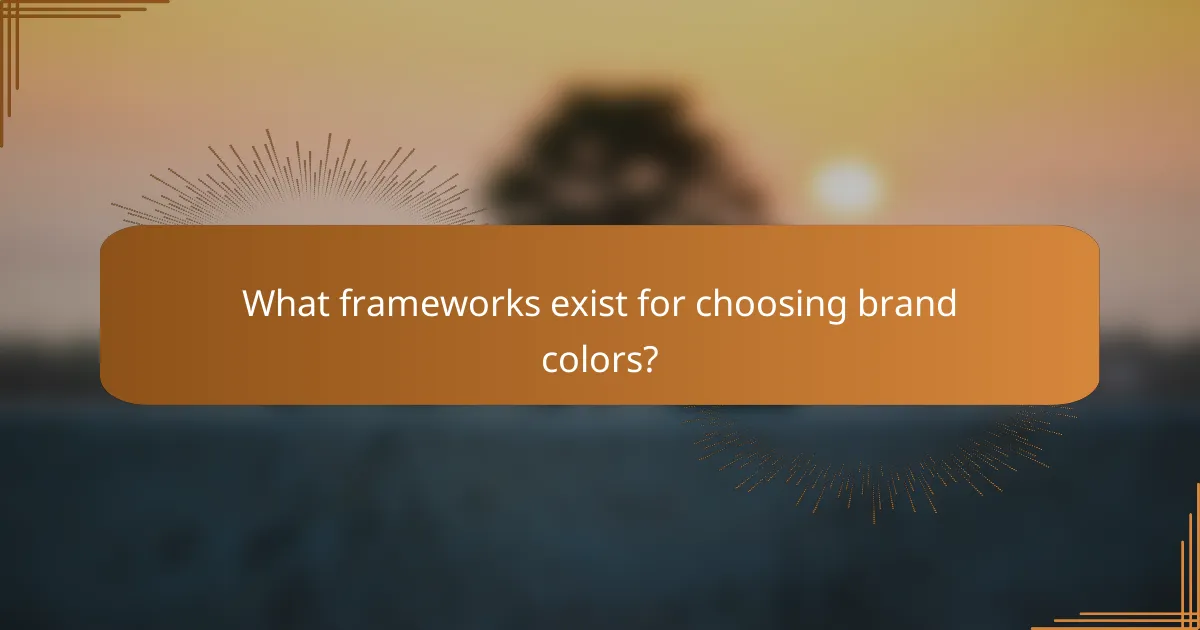
What frameworks exist for choosing brand colors?
Several frameworks can guide the selection of brand colors, focusing on psychological impact and visual harmony. These frameworks help brands convey their identity and connect emotionally with their audience.
Color wheel and harmony principles
The color wheel is a fundamental tool in color theory, illustrating the relationships between colors. It helps identify complementary, analogous, and triadic color schemes that can create visual harmony in branding.
When choosing colors, consider using complementary colors for contrast or analogous colors for a more cohesive look. For example, a blue and orange combination can create excitement, while shades of blue and green can evoke calmness.
Emotional branding frameworks
Emotional branding frameworks focus on how colors can evoke specific feelings and associations. Different colors can trigger various emotions; for instance, red often signifies passion or urgency, while blue conveys trust and reliability.
To effectively use emotional branding, identify the core emotions you want your brand to evoke and select colors that align with those feelings. For example, if your brand aims to inspire creativity, consider using vibrant colors like purple or orange.
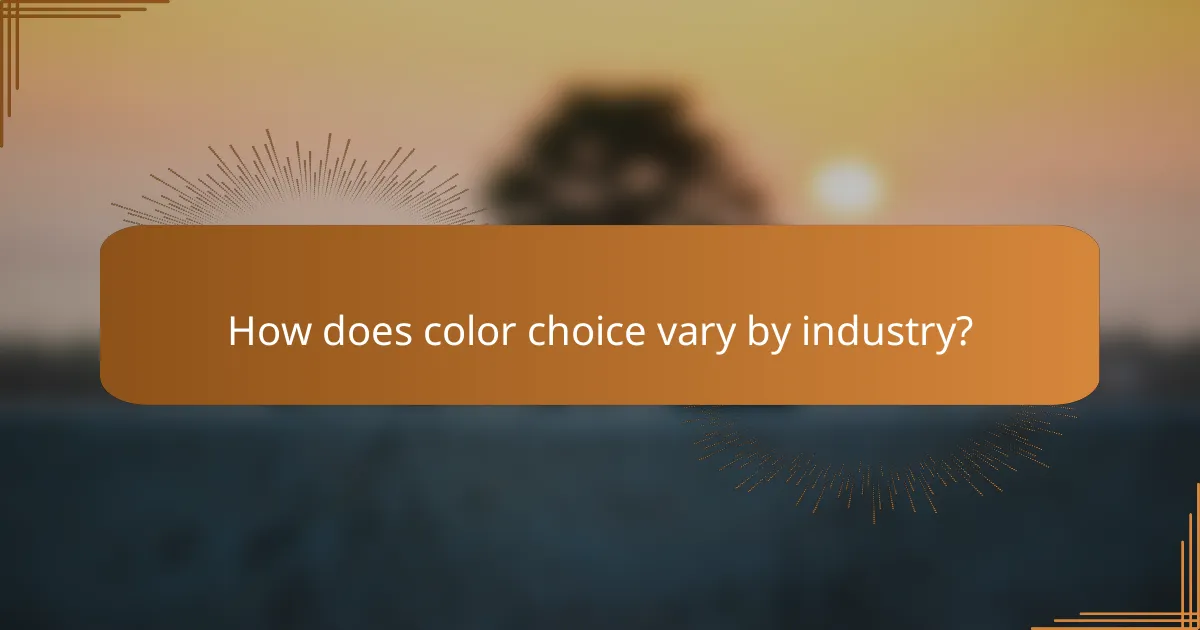
How does color choice vary by industry?
Color choice significantly varies by industry, influencing brand perception and consumer engagement. Different sectors adopt specific color palettes that resonate with their target audience, enhancing emotional connections and brand recognition.
Color trends in tech branding
In the tech industry, colors like blue, green, and black dominate branding strategies. Blue often conveys trust and reliability, making it a popular choice for companies like IBM and Facebook. Green is frequently associated with innovation and sustainability, appealing to environmentally conscious consumers.
Tech brands also experiment with vibrant colors to stand out in a competitive market. Bright hues like orange and purple can evoke creativity and excitement, attracting a younger demographic. However, companies should maintain a balance to avoid overwhelming potential customers.
Color preferences in food and beverage
In the food and beverage sector, color choices are crucial for evoking appetite and emotional responses. Warm colors like red and yellow are commonly used as they stimulate hunger and create a sense of urgency, often seen in fast-food chains like McDonald’s and KFC.
Conversely, brands focusing on health and wellness tend to favor greens and earth tones, which suggest freshness and organic qualities. For instance, brands like Whole Foods and Tropicana utilize these colors to convey a commitment to natural ingredients. Understanding these color preferences can significantly impact marketing strategies and consumer engagement.
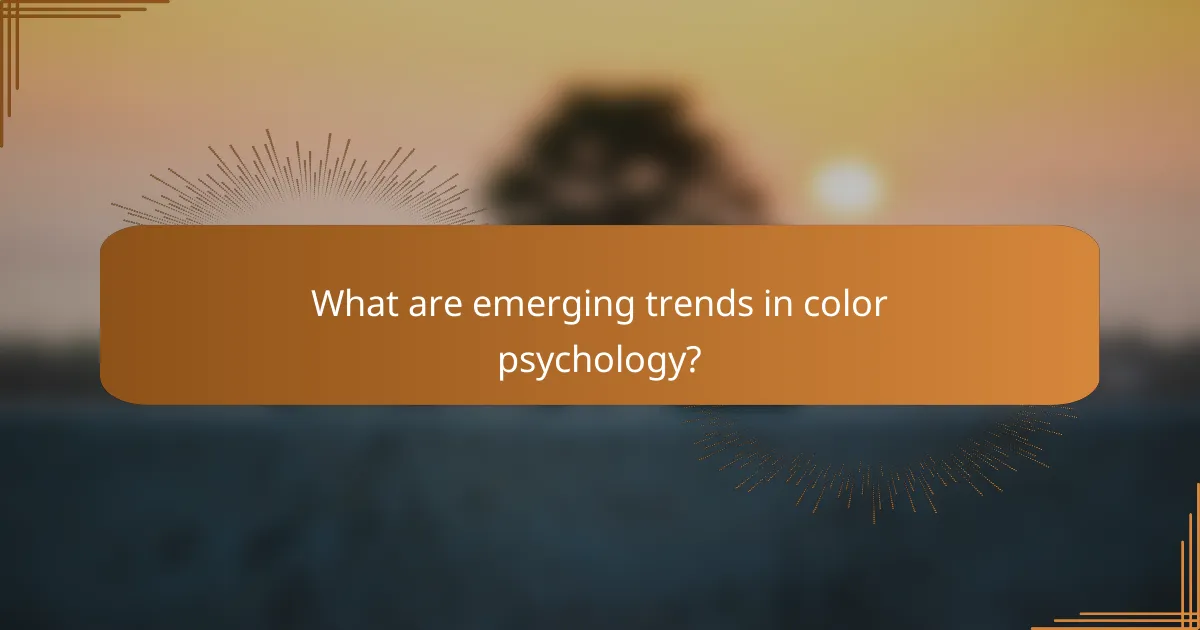
What are emerging trends in color psychology?
Emerging trends in color psychology highlight the evolving relationship between color and consumer behavior, particularly in digital environments. Brands are increasingly leveraging color to evoke specific emotions and enhance engagement, adapting to cultural shifts and technological advancements.
Influence of digital media on color perception
Digital media significantly alters how colors are perceived, as screens can display colors differently based on settings and lighting conditions. For instance, vibrant colors may appear more saturated on mobile devices, influencing user engagement and emotional response. Brands must consider these variances when designing digital content to ensure consistent brand perception across platforms.
Moreover, the rise of social media has led to trends where certain colors become associated with specific emotions or experiences, shaping consumer expectations. For example, pastel colors often evoke feelings of calmness and nostalgia, making them popular in lifestyle branding.
Future color trends in branding
Future color trends in branding are likely to focus on sustainability and authenticity, with brands opting for earthy tones that reflect eco-conscious values. These colors not only resonate with environmentally aware consumers but also enhance brand trust and loyalty. Expect to see a shift towards muted palettes that convey a sense of simplicity and transparency.
Additionally, the integration of augmented reality (AR) in marketing will influence color choices, as brands will need to consider how colors appear in different environments. This technology allows consumers to visualize products in their own spaces, making color accuracy crucial for effective branding.
